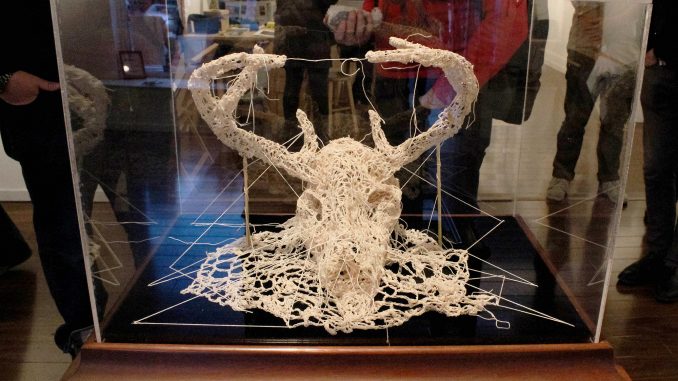
When it comes to the art of crocheting, Caitlin McCormack prefers skeletons to scarves.
For almost five years, the Philadelphia-based artist has woven stiffened string into brittle bones in an intricate exploration of death and grief.
“It felt kind of comforting,” McCormack said. “It opened me up to how universal grief is and how everyone shares it.”
Currently, McCormack’s delicate anatomical art coils against black velvet and twists beneath protective shields of glass at the Paradigm Gallery on 4th Street near Fitzwater in a solo exhibition, “Mnemosyne.”
The show’s title refers to the Titaness in Greek mythology who represents memory—a source of inspiration in McCormack’s work.
“These pieces are tapping into old memories for people but also creating new memories,” said gallery co-founder Sara McCorriston. “It’s part of this ongoing cycle.”
McCorriston and McCormack’s paths first crossed when they were placed in the same costume design class at the University of the Arts. After they graduated, McCorriston gravitated toward curation and went on to create Paradigm with co-director Jason Chen.
Shortly after she left the University of the Arts with a BFA in illustration, McCormack found herself grappling with the deaths of her grandparents. The life-changing turn of events inspired her distinctive artistic voice.
McCormack’s grandmother taught her how to crochet years before; her grandfather carved elaborate birds from wood.
“I wanted to do something meditative and kind of repetitive to help me deal with the grief, so I decided to create kind of a synthesis of both of their art forms and that came out of it,” McCormack said.
As her grandfather once did, McCormack renders representations of animals, choosing both mythological and real creatures that represent significant events in her own memory. For example, a crocheted sculpture of a kitten’s skeleton on display symbolizes McCormack’s one-year-old black cat that she fears losing one day.
“I associate certain events with the squirrel that I saw outside the window when I was having a fight with this person, or the dog that walked down the street when I was coping with this,” McCormack said. “My memories kind of cling to whatever animal was present at the time.”
After studying and sketching the skeleton of an animal, McCormack begins to crochet parts and pieces using symbolic numbers instead of patterns and fine cotton string instead of yarn.
Just as time and emotion often alter one’s perception of the past, McCormack said she freely allows her “pseudoscientific” work to diverge from anatomical accuracy.
“I don’t want to render a spot-on representation of the form,” McCormack said. “I want it to be kind of warped by time and memory and my own visual biases.”
Although “Mnemosyne” is the third exhibition at Paradigm to showcase McCormack’s crocheted works, both McCormack and McCorriston have noticed a shift in the art form as it has grown and developed.
“I think I’ve seen the extent of it and then she surprises me again,” McCorriston said.
“Storm of Uncles,” one of the more grandiose pieces in the exhibit, includes a menagerie of skeletons that McCormack has seemingly suspended using carefully calculated cuts of plexiglass. The piece—encased in a glass box more than three feet tall—was a challenge for McCormack, but has presented a new direction for the artist, who said she intends to experiment with depth and hovering figures.
“It’s a piece you stand in front of and observe for such a longtime, and every time I find myself going back and standing in front of it still regularly because there’s so many things I’m feeling about it and taking from it,” McCorriston said.
Recently, McCormack has been working through the medium of vintage furniture. Works like “Mansion of Prodigies” displays a hulking crocheted figure atop an antique bureau, with skeletons lurking inside of the chest’s drawers.
“The work isn’t made to be seen necessarily—it’s made to be found,” McCormack said.
The exhibit will remain on display at Paradigm until Dec. 12.
Angela Gervasi can be reached at angela.gervasi@temple.edu.



Be the first to comment